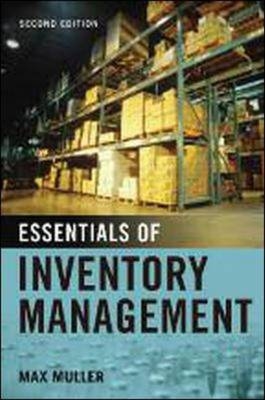
Essentials of Inventory Management
Amacom (Verlag)
978-0-8144-1655-6 (ISBN)
- Titel ist leider vergriffen;
keine Neuauflage - Artikel merken
Inventory management is about more than counting what you’ve got. It’s about understanding business realities and making decisions that balance current demand with future needs while keeping overhead and operating costs to a minimum.Now in its Second Edition, Essentials of Inventory Management gives inventory professionals the information they need to maximize productivity in key areas, from physical stock issues to problem identification and resolution to technologies like RFID and other automated inventory mechanisms. Perfect for novice and veteran managers alike, this ultra-practical book covers topics such as:
Forecasting and replenishment strategiesDifferences between retail and manufacturing inventoriesMaterials requirements planning and just-in-time inventory systemsSimple formulas for calculating quantities and schedulesManagement of inventory as a physical reality and a monetary value Supply chain risk management
Complete with detailed examples, handy tools, and a revised and expanded chapter analyzing “Why Inventory Systems Fail and How to Fix Them,” this nontechnical yet throrough guide is perfect for both instructional and on-the-job use.
Max Muller (Overland Park, KS) has been an executive for a wide range of product distributors. His seminars throughout the United States, Canada, and the United Kingdom have drawn more than 100,000 attendees. His books include The Manager’s Guide to HR (978-0-8144-1076-9).
Contents
Preface to the Second Edition
Chapter 1 Inventory as Both a Tangible and an
Intangible Object
Inventory—Who Needs It?
Inventory Costs
The Purpose of Inventory
Types of Stock
Tracking the Paper Life
Electronic Data Interchange
Recap
Review Questions
Chapter 2 Inventory as Money
Accounting for Inventories
How Inventory Is Valued Inventory on the Balance Sheet
Inventory on the Income Statement
Ratio Analyses and What they Mean
Current Ratio
Quick Ratio or Acid Test
Inventory Turnover Ratio
Profit Margins
Calculating Gross Profit
Merchandising Metrics
Pricing Generally
Selling Price
Obsolete Stock
Why You Have Been Told Not to Dispose of
Obsolete Stock
Problems with Convincing Decision Makers
That “It’s Gotta Go”
Arguments in Favor of Disposing of Dead Stock
Methods of Disposal
Carrying Cost and Purchasing
Recap
Review Questions
Chapter 3 Physical Location and Control of Inventory
Common Locator Systems
Memory Systems
Fixed Location Systems
Zoning Systems
Random Locator Systems
Combination Systems
Common Item Placement Theories
Inventory Stratification
Family Grouping
Special Considerations
Location Addresses and SKU Identifiers
Significance
Keys to Effectively Tying Together SKUs and
Location Addresses
Recap
Review Questions
Chapter 4 Automatic Identification
The Basics of Bar Coding
Elements of a Bar Code Symbol
Structure of a Generic Bar Code Symbol 96
Quiet Zone
Start and Stop Characters
Data Characters
“X” Dimension
Symbologies: Bar Coding Structural Rules
Discrete and Continuous Symbologies
Symbology Summary
Popular Symbologies Found in the
Inventory World
Scanning Basics
Printing Basics
Bar Code Applications
The Basics of Radio-Frequency Identification
RFID Tag Types and Classes
Bar Code versus RFID
RFID Item Identification
The Advantages of RFID
The Problems Associated with RFID
Lack of RFID Standards
Money, Money, Money
System Disruption Vulnerability
RFID Reader Collision
RFID Tag Collision
Security, Privacy, and Ethics Problems with RFID
Recap
Review Questions
Chapter 5 Planning and Replenishment Concept
Replenishment Costs
Types of Inventory Management
Independent Demand Inventory
Economic Order Quantity Formula
Dependent Demand Inventory
Inventory Objectives
Enterprise Resource Planning
Recap
Review Questions
Chapter 6 Why Inventory Systems Fail and How to
Fix Them
Inventory system Failure: A Case Example
Discussion of Example Case
Metrics
Inventory Record Accuracy
Fill Rates
Tools with Which to Uncover System
Dysfunctions
Run Charts
Flow Charts
Logic Charts
Variance Reports
Cycle Counting
Annual Inventories
Cycle Counting
Cycle Count Methodologies
Control Group Cycle Counting Method
Location Audit Cycle Counting Method
Random Selection Cycle Counting Method
Diminishing Population Cycle Counting
Method
Product Categories Cycle Counting
Method
A-B-C Analysis Cycle Counting Method
When to Count
Who Should Count
Recap
Review Questions
Chapter 7 Basics of Supply Chain Risk Management
SCM in a Perfect World
Primary Risks in SCM
Globalization and Supply Chain Complexity
Conflicting Interests
System Fluctuations Over Time
Evolving Relationships
Product Complexity
Inadequacy of Insurance
Suppliers
The Bullwhip Effect
Disruption in Communications
Inadequate Software
Suggested Solutions to SCM Problems
Analysis of Risks
Supplier Assessment
Lessen the Bullwhip Effect through Coordination
Within the Supply Chain
Contracts That Do and Don’t Coordinate the
Supply Chain
Inventory Levels
Recap
Review Questions
Bibliography
Index
| Erscheint lt. Verlag | 16.6.2011 |
|---|---|
| Sprache | englisch |
| Maße | 62 x 92 mm |
| Gewicht | 1 g |
| Themenwelt | Wirtschaft ► Betriebswirtschaft / Management ► Marketing / Vertrieb |
| Wirtschaft ► Betriebswirtschaft / Management ► Unternehmensführung / Management | |
| ISBN-10 | 0-8144-1655-1 / 0814416551 |
| ISBN-13 | 978-0-8144-1655-6 / 9780814416556 |
| Zustand | Neuware |
| Haben Sie eine Frage zum Produkt? |
aus dem Bereich


